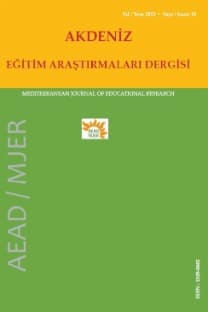Ergenlerin stresle basa çıkma stratejileri ile sürekli öfke öfke tarzları arasındaki iliskinin incelenmesi
Bu arastırmanın amacı disiplin suçu islemis erkek ergenlerin stress yönetim tarzları ile sürekli öfke-öfke tarzları arasındaki iliskinin incelenmesidir. Çalısma evreni, KKTC meslek lisesi öğrencileridir. Disiplin suçu islemis meslek lisesi öğrencilerinden uygun örnekleme yöntemi ile belirlenen 52 erkek öğrenci, arastırmaya dahil edilmistir. Veri toplama aracı olarak , Özer (1994) tarafından Türkçe’ye uyarlaması yapılan, Sürekli Öfke ve Öfke Tarz ölçeği ile Sahin ve Durak tarafından uyarlaması yapılan “Stresle Basa Çıkma Stratejileri Ölçeği” kullanılmıstır. Sürekli Öfke ve Öfke Tarz ölçeği Türkçe formunda Cronbach Alfa değerleri ayrı ayrı hesaplanmıs olup "Sürekli Öfke" boyutu için .79; "kontrol altına alınmıs öfke" boyutu için .84 "dısa vurulmus öfke" boyutu için .78 ve "bastırılmıs öfke" boyutu için ise .62 olarak bulunmustur.“Stresle Basa Çıkma Stratejileri Ölçeği” Cronbach alpha güvenirlik katsayısı 0,47 ile 0,80 arasında değismektedir. Verilerin analizinde SPSS (Statistical Package for the Social Science)11.0 paket programı kullanılmıstır. Veriler için Pearson momentler çarpımı, aritmetik ortalama, tek yönlü varyans analizi (ANOVA) ve t-testi uygulanmıstır. Bu arastırmada anlamlılık düzeyi 0.05 olarak alınmıstır. Arastırma sonucunda, disiplin suçu isleyen erkek öğrencilerin, Stresle Basa Çıkma Stratejileri ile Sürekli Öfke ve Öfke Tarz Alt Ölçekleri arasında anlamlı iliskiler bulunmustur. Ayrıca Stresle Basa Çıkma Stratejileri ile Sürekli Öfke ve Öfke Tarz Alt Ölçekleri, sosyodemografik özelliklere göre anlamlı olarak farklılastığı saptanmıstır.
The relationship between adolescents’ Stress Struggle Strategies and Continous Anger-Anger Manner
The aim of this research is to investigate on the relationship between male adolescents’ strategy on combating with stress who have commited disciplinary crime and continuous anger-anger manner. Research population is based on students in TRNC attending mesleki high schools. 52 students out of the ones who commited disciplinary crime are sampled by appropriate sampling method and included in the research. For data gathering tool, “Continuous Anger-Anger Manner Scale” by Özer (1994) and “Stress Management Strategies Scale” adopted by Sahin and Durak is used in the research. Continuous Anger-Anger Manner Scale in Turhish form is calculated separately for Cronbach Alpha values, dimensions for “Continuous Anger” , “anger under control”, “observed anger” are found .79, .84, .78, .62, respectively. “Stress Management Strategies Scale” Cronbach alpha trust coefficient is varying between 0.47 and 0.80. In the analysis of data SPSS (Statistical Package for the Social Science)11.0 package program is used.For data, Pearson moments multiplication, arithmetic average,single-sided variance analsis (ANOVA) and t-test is employed. Significance level is taken as 0.05 in the research. In conclusion of the research, for male adolescents’ who commited disciplinary crime, it has been found that there are significant relationship between Stress Managemt Strategies Scale and Anger-Anger Manner Scale. Furhermore, it has been observed that Stress Managemt Strategies Scale and Anger-Anger Manner Scale Lower Scale are significantly varying depending on sociodemographic features.
___
Beidel, D.C. & Turner, S.M. (1998). Shy children, phobic adults: The nature and treatment of social phobia. Washington DC: American Psychological Association.Banerjee, R.& Henderson, L. (2001). Social-cognitive factors in childhood social anxiety: a preliminary investigation. Social Development, 10, 4, 558-572.
Bartek SE, Krebs DL, Taylor MC (1993) Coping, defending, and the relations between moral judgement and moral behavior in prostitutes and other female juvenile delinquents. J. Abnorm Psychol 102: 66-73.
Bridewell, Will B. ve Edward C. Chang “Distinguishing between Anxiety, Depression, And Hostility: Relations to Anger-In, Anger-Out, and Anger Control” Personal Individual Differences, vol: 22, no: 4, 1997, ss.587-590.
Clark, D.M. & McManus, F. (2002). Information processing in social phobia. Biological Psychiatry, 51, 92-100.
Gündüz B.: Hemsirelerde Stresle Basaçıkma Biçimleri ile Tükenmislik Arasındaki iliskilerin incelenmesi. s.25-28. Karadeniz Teknik Üniversitesi Sosyal Bilimler Enstitüsü, Yüksek Lisans Tezi, Trabzon, 2000 .
Karasar, N. (2006). Bilimsel arastırma yöntemi. Ankara: Nobel Yayın Dağıtım.
Kashani, J. H. ve Confield, L. A. (1995). “Psychiatric inpatient children’s family perceptions and anger expression”, Journal of Emotional and Behavioral Disorders,3, 1.
Özer, Kadir A. “Öfke Kaygı ve Depresyon Eğilimlerinin Bilissel Alt Yapıyla İliskisi.” Türk Psikoloji Dergisi, cilt:9 Sayı:31, 1994a, ss.12-25.
Özer, Kadir A. “Sürekli Öfke (SL-Öfke) ve Öfke İfade Tarzı(Öfke-Tarz) Ölçekleri Ön Çalısması.” Türk Psikoloji Dergisi, cilt:9 Sayı:31, 1994b, ss.26-35.
“Spielberger, C. D. (1991). State-Trait Anger Expression Inventory. Odessa, Sorida: Psychological Assessment Resources.” Aktaran Bridewell, Will B. ve Edward C.Chang. Distinguishing Between Anxiety, Depression, and Hostility: Relations ToAnger-In, Anger-Out, and Anger Control. Personality and Individual Differences vol. 22, no. 4, 1997, ss.587–590.
Yavuzer, H. (1992). Çocuk ve Suç. İstanbul: Remzi Kitabevi. Feindler, E. L. (1990). Adolescent anger control: Review and critique. Progress in Behavior Modification, 26, 11-59.
Rose, S.D. (1998). Group therapy with troubled youth. Sage Publications, Inc. Leary MR & Kowalski RM. (1997). Social anxiety. New York: Guilford.
Kısaç,Đ. 1996. Üniversite öğrencilerinin bazı değiskenlere göre öfke ifade düzeyleri. Doktora tezi (yayınlanmamıs), Hacettepe Üniversitesi, Ankara.
Synder, C. R., (1991). The Will and the ways: Development and the validation of individualdifferences measure of hope. Journal of personality and social Psychology, 60:570- 585
Johnson V, Pandina RJ (1991) Effects of the family environment on adolescent substance use,delinquency, and coping styles. Am J Drug Alcohol Abuse 17: 71-88.
Steiner H, Feldman SS (1995) Two approaches in the measurement of adaptive style comparison of normal, psychosomatic ill, and delinquent adolescents. J. Am AcadChild Adolesc Psychiatry 34: 180-190.
Greenberger, E. & McLaughlin, C.S. (1998). Attachment, coping, and explanatory style in late adolescence. Journal of Youth and Adolescence, 27 (2), 121-139.
- ISSN: 1309-0682
- Yayın Aralığı: Yılda 4 Sayı
- Başlangıç: 2008
- Yayıncı: Tayfun Taşbilek
Sayıdaki Diğer Makaleler
Kamu ve özel ilköğretim okullarında bilgi yönetimi
AYNUR BOZKURT BOSTANCI, Hatice SAP
Okul öncesi Öğretmen adaylarının Okulda siddetin kaynağı üzerine algıları
Sinan KOÇYİĞİT, Kerim GÜNDOĞDU, Erdal BAY
Yasar BOZ, Ömer YILMAZ, Necmi EŞGİ
Max Weber’in Bürokratik Örgüt anlayısının Kuzey Kıbrıs’taki okullardaki uygulanısı
